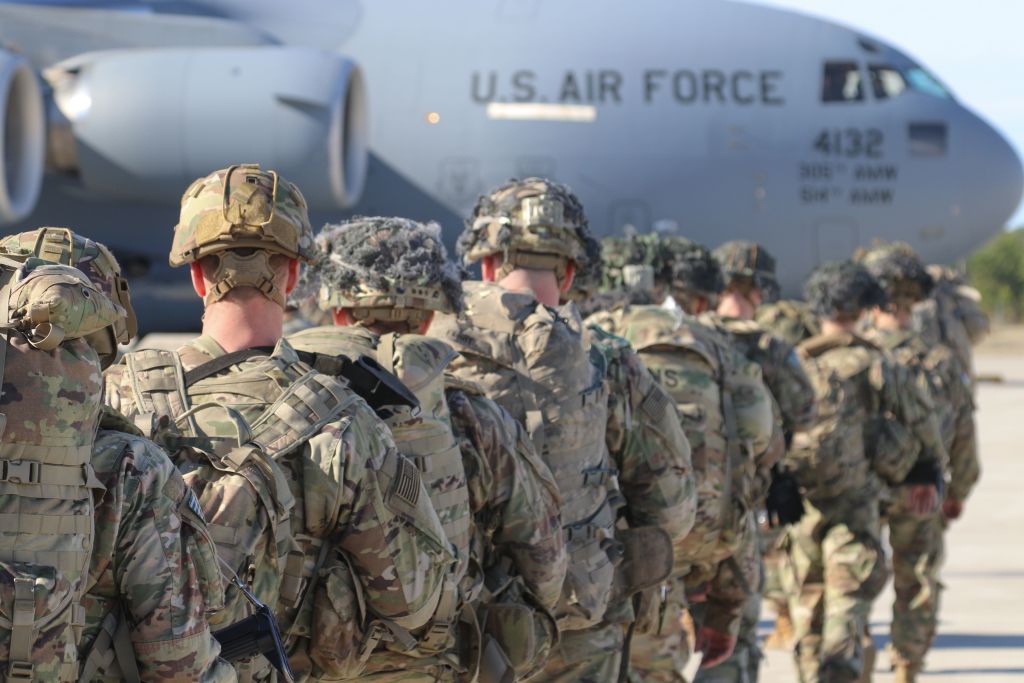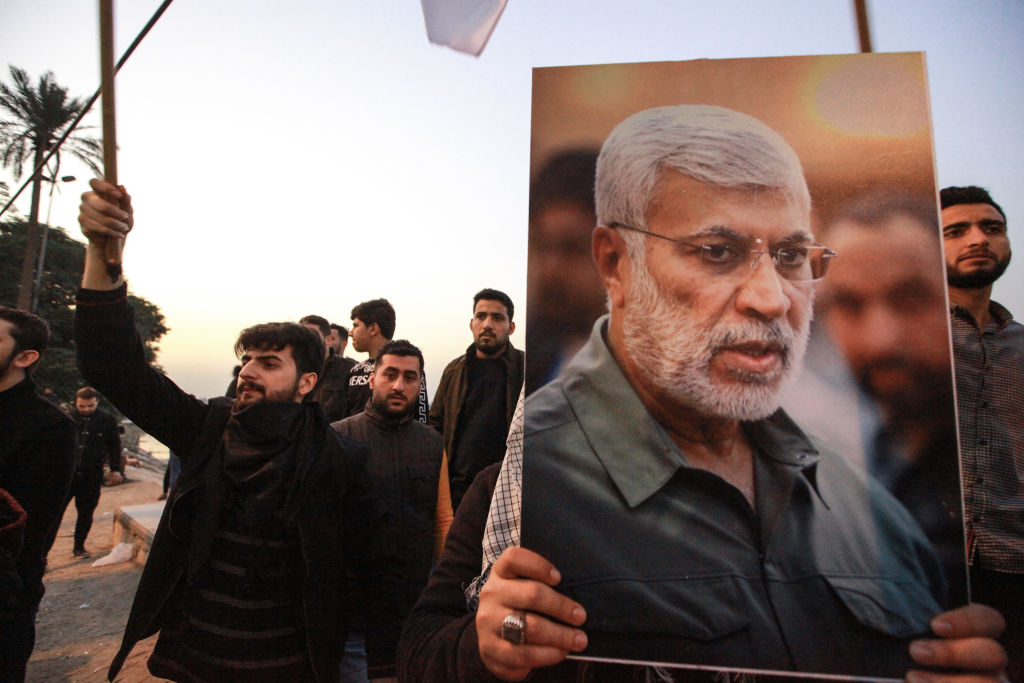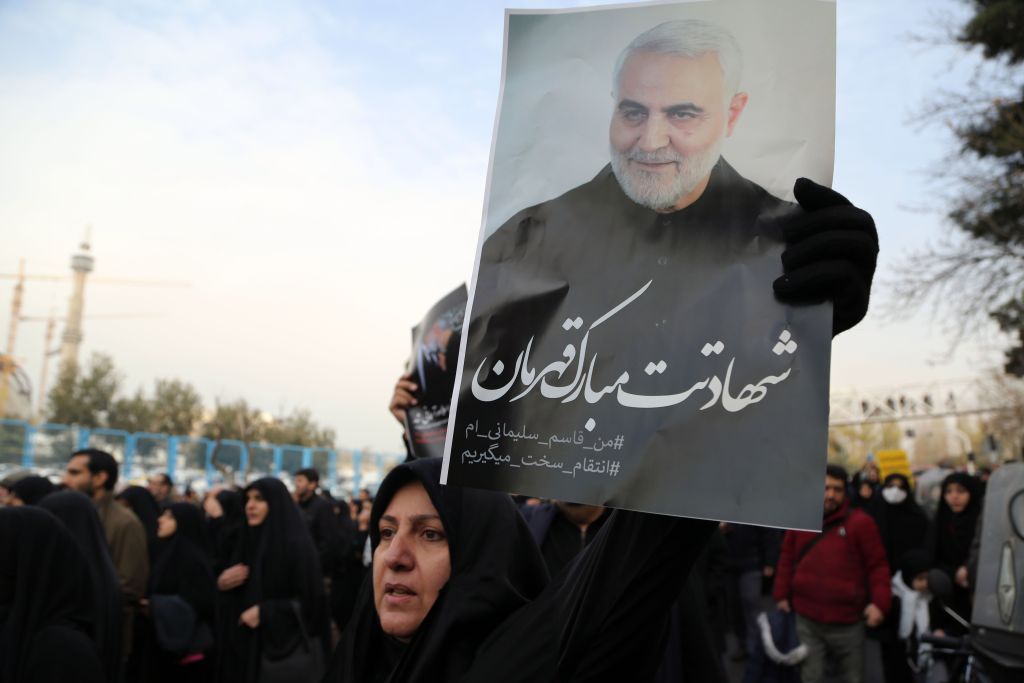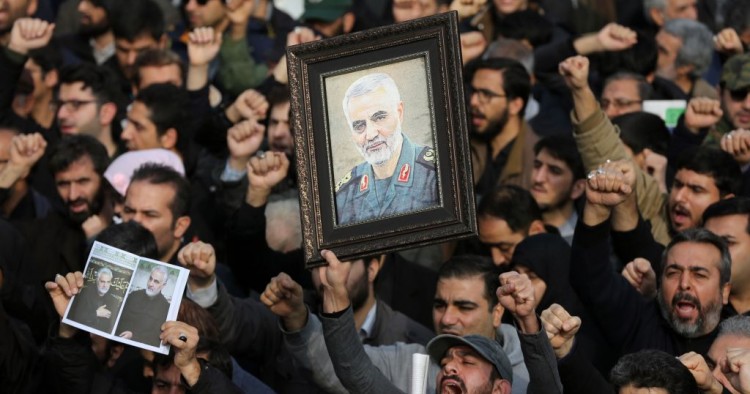A turning point, but not necessarily a prelude to war
Alex Vatanka
Senior Fellow
The Trump administration’s decision to assassinate Iran’s Gen. Qassem Soleimani, head of the Revolutionary Guards Quds Force, is a turning point in U.S.-Iran relations. That said, it is not necessarily a prelude to war. The immediate reaction in Iran — from Supreme Leader Ali Khamenei to the top commanders of the Revolutionary Guards — has been to vow revenge.
But while the pressure in Tehran to retaliate will be considerable, if for no reason other than to save face and prevent despair in the ranks of the regime, the Iranian Islamist system is hardly suicidal. No one in Tehran can now afford to test the limits of Donald Trump’s unpredictability. He is the man who for years lamented American interventions in the Middle East only to shock the Iranians by killing the leading symbol of Iran’s regional agenda.
Put simply, Khamenei and the rest of the regime now have to reexamine all their earlier calculations about Trump and this American administration’s willingness for a full-out war. Tehran has three main options. It can lash out at the U.S. and all things American in the Middle East and beyond — from targeting U.S. officials to firing off missiles at U.S. bases in the region. The U.S. government’s call that all Americans immediately leave Iraq shows that Washington sees this as a possible scenario in certain areas.
Second, the regime in Tehran can take its time and consider its countermove while it exploits Soleimani’s assassination to shore up nationalist fervor at home. The desperately unpopular Islamic Republic needs any injection of legitimacy it can secure and will do its utmost to continue to portray Soleimani as a hero who defended the Iranian nation.
This takes us to third option, which is a broader reassessment of whether Iran can sustain its ideological course, which it calls the “Axis of Resistance.” Soleimani was the embodiment of Tehran’s 40-year quest to export its version of militant Islam to nearby countries. This quest began in 1979 when Ayatollah Ruhollah Khomeini took control of Iran. Opportunities for Iran to intervene in Iraq after 2003 and in Syria, Yemen, and elsewhere after 2011, which the likes of Soleimani called “Forward Defense,” merely supercharged an effort already in motion by Tehran to reshape the Middle East.
This Iranian approach continued, with Soleimani as the spearhead, but now the pushback is bound to raise tough questions in Tehran. Not only is the Iranian population overwhelmingly against the regime’s militant foreign policy, but recent anti-Iran protests in Iraq underline the limitations of the “Axis of Resistance” project. The fact that Soleimani was not killed on Iranian soil but in Baghdad makes him less of an Iranian hero and more of a militant Islamist who put his ideology ahead of his country’s interests.
That is at least a common and profound sentiment among Iranians inside and outside of the country. Meanwhile, it is for Khamenei and his cohorts in the Revolutionary Guards to decide whether they are confident enough that significant escalation against the Trump administration is something they can pull off given pressures at home and abroad for Tehran to change course.

The old rules of the game have been shattered
Randa Slim
Senior Fellow, Director of Conflict Resolution and Track II Dialogues Program
The killing of Gen. Qassem Soleimani, head of Iran’s Revolutionary Guards Quds Force, was a major and unexpected blow to the Iranian leadership. It punctured the aura of invincibility and the hubris that have characterized Soleimani and his colleagues’ behavior. Soleimani was killed primarily because he felt he was untouchable. Otherwise, he would not have let his guard down in a country where the United States has thousands of soldiers stationed and a good intelligence ground game, especially after ordering an Iraqi militia funded by his Quds Force to storm the U.S. embassy — a humiliating, “in your face” move against a United States whose president takes such acts of public affront very personally.
Provided a rare set of circumstances backed by strong intelligence allowing a clear hit on Soleimani, it should not be surprising that Donald Trump decided to go for the kill. The “maximum pressure” campaign was not yielding the concessions he needed from Iran fast enough. A “maximum kill” operation against the mastermind of Iran’s successful regional strategy and proxy network would publicly humiliate the Iranian leadership, force a reckoning among its allies on the limits of Iranian power, and rearrange the board of the chess game Iran has been playing to his favor — or so Trump hopes.
The Iranian Supreme National Security Council has already vowed a decisive retaliation involving multiple fronts in the region. This is a response that will likely evolve over a period of time and not be a one-off strike, and unlike previous Iranian-engineered attacks in the region and elsewhere, Tehran will want to own this retaliation. Its scale will be proportional to the stature and esteem Soleimani held in Iran. U.S. human assets in the region are at great risk today. Iranian allies and proxies will be dragged into this escalation and as a result, civilians will pay the price.
Has the Trump administration pre-gamed the attack and its likely consequences? Does it have a roadmap for what comes next? Given its track record to date with inter-agency processes, it is highly unlikely it did either. This means the U.S. and Iran are getting locked in an endless cycle of attacks and counterattacks that raise tensions in an already unstable region.
There are no offramps at the moment to get off this escalatory trajectory. Regional countries like Oman need to step up their efforts to create some. The U.S. might need to look up the Israeli-Hezbollah playbook. Since 2006, every escalation between the two sides has followed a carefully prescribed script of tit-for-tat proportionality that is immediately followed by messaging by both sides of a desire to restore the mutual deterrence status quo. In the case of the U.S.-Iran conflict, the old rules of the game that have governed their competition have been shattered. We have entered a new normal that lacks rules. It might be the case that as the two countries re-negotiate new rules through violent attacks and counterattacks, they stumble into a major regional confrontation. To date, both sides have not expressed an interest in engaging in such a war. But the man who used to be the tempo-setter and mastermind of calibrated Iranian escalation against the U.S. is now gone.

The region has just become more complicated
General (ret.) Joseph Votel
Distinguished Senior Fellow on National Security
Qassem Soleimani was a bad actor with significant American blood on his hands. As our former Special Envoy for Combatting ISIS, Brett McGurk, observed, there is a deserving measure of justice here. He had his fingerprints on virtually every nefarious activity that Iran was involved with. In my estimation, he was a driver of instability in the region. Additionally, if he was indeed plotting against our people or interests (and I trust our IC professionals and their assessments), then we have an obligation to protect ourselves.
The region, if possible, has just become more complicated. There are unknown consequences for force protection, partnerships, regional security, and both our strategy against Iran (the “maximum pressure” campaign) and the National Defense Strategy, which prioritizes our competitive advantage against Great Powers. After a career in the military with a lot of time spent in this region, I have learned that you must respect your adversaries and their ability to hurt us. Iran has sophisticated capabilities and multiple ways that they can respond to this strike. We will have to maintain high vigilance and readiness to protect ourselves and our interests. Going forward, it is important to explain our actions, clarify our strategy, re-affirm our national interests, and take action to sustain our important relationships in the region.

US airstrike prompts widespread Iraqi criticism
Robert Ford
Senior Fellow
Condemnation of the American airstrike at Baghdad airport on Jan. 3 was widespread in Iraq; no prominent Iraqi figure inside the country praised it. Criticism focused on the alleged violation of Iraqi sovereignty since the Americans did not first get Iraqi government approval for the strike and it also killed Abu Mahdi al-Muhandis, the deputy commander of the Iranian-backed Popular Mobilization Forces (PMF) militias organization and a senior Iraqi official. Some Iraqis, notably interim Prime Minister Adel Abdul-Mahdi as well as a senior Iraqi military official, also highlighted that the American strike violated the bilateral agreement about the mission for U.S. forces in Iraq to help build up Iraqi forces fighting ISIS.
In the wake of the airstrike, there have been many calls inside Iraq for restraint among Iraqis and between the Americans and the Iranians, most notably from the Shi’a clerical establishment in Najaf. There is a wide consensus in Iraq that the country should not be at the center of an American-Iranian military fight. Iraqi politicians are more divided on the utility of keeping American forces in Iraq. PMF officials and their political allies want the Iraqi Parliament to pass legislation that would oblige Abdul-Mahdi’s government to expel the American military. Those publicly calling for expulsion of American forces have or are near a parliamentary majority. Some Kurdish and Sunni Arab parliamentarians may skip the special Parliament session scheduled for Sunday to address the American strike in order to block a quorum and any parliamentary action. Blockage in the Parliament would reinforce the stalemate in Baghdad generated by the national street protest movement against the government that has prevented the appointment of a new prime minister. If Parliament cannot move, some militia hardliners will have justification to retaliate by other means against the U.S.

A new escalation in the US-Iran crisis
Paul Salem
President
The killing of Gen. Qassem Soleimani marks a new escalation in the U.S.-Iran crisis. Since May, it was Iran that was escalating and Donald Trump who was not taking the bait; now it is the U.S. that has escalated in a significant way. We shall see where and in what way Iran responds.
We must keep in mind that Iran exercises what Barack Obama liked to call “strategic patience.” They pursue strategies and tactics that serve their interests, not emotions. Their interests remain to get Trump to ease off on crippling economic sanctions; to maintain or increase their influence in Iraq, Syria, and Lebanon; and to maintain regime security at home. The death of a senior military officer of theirs is significant but doesn’t change their institutional relations, their interests, or their overall strategy.
I see major repercussions in two arenas. First, in Iraq: it has been a long-term interest of Iran to push the U.S. out of its neighbor. It pivoted to this arena after escalations in the Gulf earlier in the year failed to get Trump’s attention. And it was in the context of Iran-backed attacks on U.S. assets in Iraq that the airstrike that killed Soleimani occurred. I expect that Iran will redouble its efforts — using security and political levers — to try to push the U.S. out of Iraq.
Second, in the region: Iran is likely to claim a “measured response,” and to attempt assassination of U.S. military, diplomatic, or other officials and/or personnel as their own official was targeted. Iran has a wide range of operations in both Iraq and Lebanon, but they could target U.S. personnel or assets in other parts of the Middle East as well.
Iran is still keenly interested in pushing Trump to offer direct or indirect economic relief. Through proxy operations against U.S. personnel or embassies, they could give Trump “several Benghazis” to get his attention during this election year.
Iran has no strategic or tactical interest in a region-wide war or in a major war-like escalation with the U.S. They might try to attack U.S. bases or positions in the UAE or Saudi Arabia, but I doubt that they will attack UAE or Saudi assets proper.
In closing, we can expect dangerous, but not unfettered, developments in the months ahead. No de-escalation or negotiation is in sight for 2020. But 2021 — with Trump 2.0 or a Democratic president — will present a major opportunity for broad negotiation. Iran will still be desperately in need of economic relief. If it’s willing to give up its strategy of maintaining standing militias in other peoples’ countries and behave more like a state than an ongoing religious revolution, then perhaps a deal can be done.

Why now?
Bilal Saab
Senior Fellow, Director of Defense and Security Program
Just when we thought we had a good understanding of President Donald Trump’s Middle East policy — which boils down to “get out of the region and avoid another endless war there” — he pulls off something dramatic like this.
Why did Trump approve the assassination of Qassem Soleimani at this particular time, when we had him in our sights countless times before but decided not to take him down? Either Trump has become less risk-averse all of a sudden or he had no clue what he was doing. Critics of the president will gravitate toward the latter explanation, and I can’t blame them. This is someone who four years ago when he was a presidential candidate confused the Quds Force, which Soleimani directed, with the Kurds, our allies in the fight against ISIS.
But I really find it hard to believe that our generals failed to put extremely sensitive and actionable intelligence on his desk without pairing it with a thorough and comprehensive assessment of who Soleimani was and what it meant to kill him. I am also going to assume that Trump read that information, or at least some of it.
So, if he understood that this could raise the chances of war with Iran, why did he still green-light the strike? For someone who has been allergic to U.S. military involvement in the region and who has absorbed some heavy hits by the Iranians against our assets and allies in recent weeks, this seems like quite the shift. It must have shocked the hell out of the Iranians.
So, what could have possibly pushed Trump to change his approach? I can think of three factors: One, our military leaders, who will never forget Soleimani’s role in killing hundreds of American soldiers in Iraq after 2003, forcefully made their case to the president, explaining to him that the best way he could deter the Iranians and avoid war is by sending them a very stern message. Two, the elimination of such a high-profile figure like Soleimani does offer political benefits. Trump can now rightly claim whenever he debates his Democratic presidential challenger that he killed two of the most wanted and murderous men in the Middle East: ISIS’s Abu Bakr al-Baghdadi and Soleimani. Three, the president and his closest advisors do believe that the harder we hit the Iranians, through sanctions and now kinetic operations, the more likely they are to come to the negotiating table. I don’t necessarily buy that logic, but that’s been the guiding principle of the Trump administration’s Iran policy.
The Iranians will most probably retaliate (they’ve already refused to talk and vowed to avenge Soleimani’s death). How is anybody’s guess. Three years ago, I testified before the House Committee on Homeland Security on the subject of the Lebanese Hezbollah. Chairman Peter King asked me under what circumstances Iran or its allies including Hezbollah could perpetrate a terrorist attack on American soil. Well, this might just be one of those circumstances.

With Soleimani’s death, war is coming
Charles Lister
Senior Fellow, Director of the Countering Terrorism & Extremism Program
The killing of Qassem Soleimani is one of the biggest developments in the Middle East in decades — it far eclipses the deaths of Osama bin Laden or Abu Bakr al-Baghdadi in terms of strategic significance and implications.
The U.S. and Iran have been engaged in a dangerous tit-for-tat for months now, but this is a massive walk up the escalation ladder.
Israel has repeatedly spurned the opportunity to kill Soleimani for fear of the consequences of taking out Iran’s most powerful operative, someone whose power is outshone only by Iran's supreme leader.
His death is a serious loss for Iran’s regional agenda, but his “martyrdom” will likely fuel a response that will, at least in the medium term, make up for his death.
That Soleimani’s killing was an action ordered by Donald Trump, the U.S. president, is all the more surprising, given his clear determination to avoid American involvement in costly wars.
With Soleimani dead, war is coming — that seems certain, the only questions are where, in what form, and when?
While America dominates the world in terms of conventional military force, Iran’s advantage is in the asymmetric sphere, so rocket attacks, bombings, assassinations, and even attacks like the missile assault on Saudi oil facilities in September 2019 are all possible responses.
There really is no underestimating the geopolitical ramifications of this.
For starters, the U.S. presence in Syria now looks very vulnerable, having already shrunk in size and weakened in terms of credibility and partner trust.
A single attack on U.S. positions could feasibly catalyze a military withdrawal and second abandonment of the Kurds.
In Iraq, U.S. diplomatic and military facilities are almost certain to come under some form of attack and covert intimidation.
The death of Abu Mahdi al-Muhandis alongside Soleimani has just mobilized tens of thousands of Popular Mobilization Forces militiamen against America’s presence in Iraq like never before.
It’s in Iraq that Iran may have its swiftest response, but Iraq is also a complex place. Weeks of protests across Iraq have shown the popular tide sway against Iran and these newly tense circumstances could feasibly provide an environment for Iranian proxies to be perceived as the source of more problems than solutions.
Having said that, pressure will rise further in Iraq’s Parliament to push for a decree ordering the expulsion of American troops from the country.
Beyond the immediate environment, Israel may reap serious security repercussions and U.S. allies in the Gulf, particularly Bahrain, the UAE, and Saudi Arabia, could all fall victim to Iranian retaliatory measures, as could al-Udeid base in Qatar.
Soleimani’s death will be a cause for celebration for many — his role in coordinating pro-Assad crimes in Syria have seen him become a deeply reviled figure for many in the region. But sadly, it may be the likes of Syrians who suffer the consequences of this major escalation.
The Middle East Institute (MEI) is an independent, non-partisan, non-for-profit, educational organization. It does not engage in advocacy and its scholars’ opinions are their own. MEI welcomes financial donations, but retains sole editorial control over its work and its publications reflect only the authors’ views. For a listing of MEI donors, please click here.













